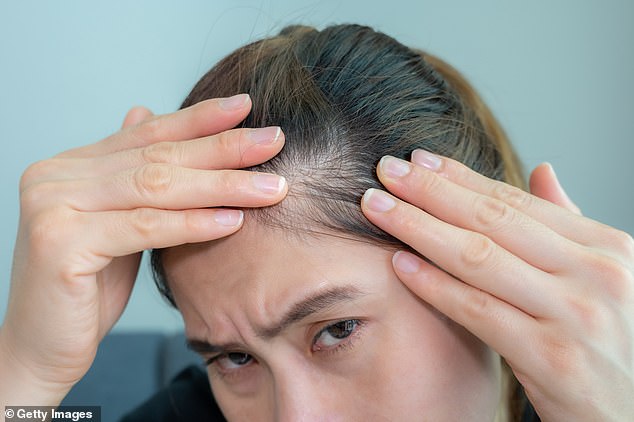The trend for tying your hair back with a claw clip is behind a surge in cases of female baldness, according to one top trichologist.
Claw clips, which come in a variety of styles and sizes, have been a fashion must-have for months, but it seems that repeated use comes with consequences, with some women complaining that their hairline has started receding, or they have noticeably bare patches.
Trichologist Rachel Valentine posted on TikTok that she had recently seen two clients with similar breakage around their crown area—and it was caused by wearing a crocodile clip in the exact same spot every day.
‘The epidemic of claw clip hairstyles is the reason you’re seeing breakage around your crown area,’ she said
‘We understand these clips are better than hair bands, and yes, they are.
‘But what isn’t good is wearing your hair in exactly the same place every day.
‘There’s a lot of tension in that same area, which causes repeated stress and breakage.’
Repeating a single style, especially tight updos or clips positioned in the same spot, can create ongoing tension on hair’s fibres, and over time this can cause a condition called tension alopecia.

Traction alopecia usually affects the hairline and crown
This is happens when the hair follicles—the tiny pores that hairs grow from—are put under so much excess tension they become inflamed and damaged, which in some cases leads to permanent baldness.
Ms Valentine advised her followers to keep using the clips but to ‘move it around your head each day’ or to alternate having your hair tied back with wearing it loose.
She said: ‘Unfortunately, any repetitive hairstyle will cause breakage because it’s the tension on the same area that causes damage.
‘Change your hair up and wear it differently every day.
‘So, claw clip one day, maybe a silk scrunchie the next, wear it high or low, and then wear it down, you’ll spread the tension around the hair, so it doesn’t cause stress just on one area.’
Echoing her advice, the team at UK Hair Transplants said that that many hair conditions can improve if caught early and some are even reversible—but the key is not to wait until it’s too late.
When it comes to traction alopecia, prevention is the best cure, so make sure that you mix up your hairstyles—and if you can’t because you need your hair pulled back for work or sports, alternate where the clip sits, high, low, or off-center
They also suggest swapping the clip for a silk or non-snag hair tie which will reduce the amount of pressure being put on the same spots.

If you like wearing a clip every day, try to position it in different places
It also pays to be mindful of tension, if a style causes tugging or scalp soreness, it’s a warning to change it.
Traction alopecia can also be triggered by weighty hair extensions and tight braids.
If you have noticed the early warning signs of traction alopecia—which is most usually in the form of thinning or snapped hair around the crown and hairline—it might not be too late to reverse the damage.
The British Association of Dermatologists say that if the tension to the hair is stopped quite early on then the follicles have a chance to heal and regrow as they once were.
However, the only cure for traction alopecia is a hair transplant, a procedure in which hair is taken from the back of the scalp and implanted in the affected areas.
It’s estimated that no more than 15 per cent of hair transplants are carried out on women, but their success rates are incredibly high, hovering around the 85 to 95 per cent mark.
Other reasons for female hair loss include hormonal changes—for instance during menopause or after pregnancy, vitamin deficiencies and genetic reasons.








